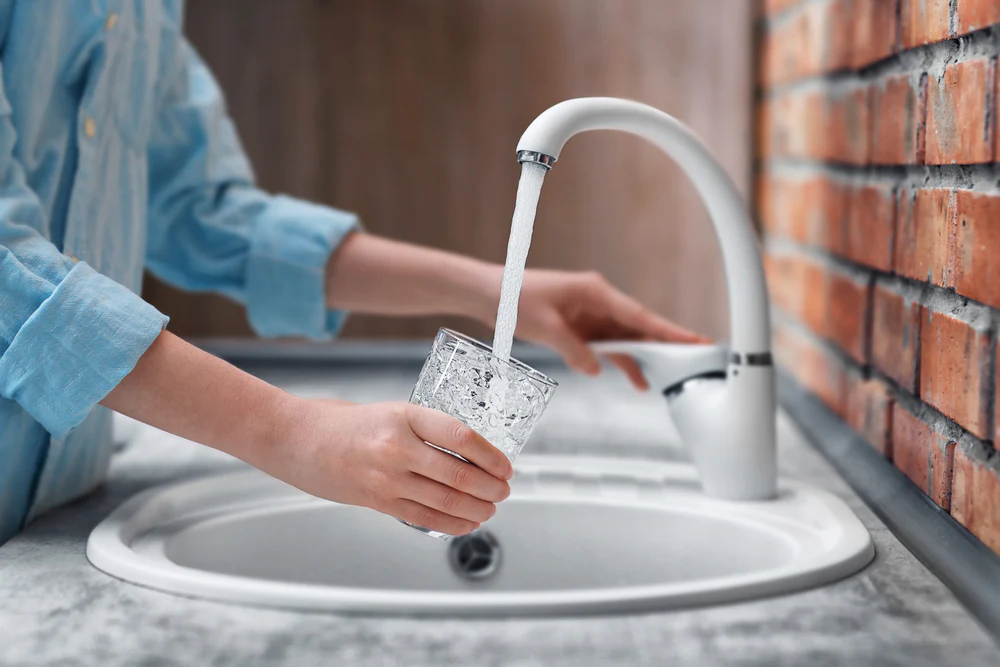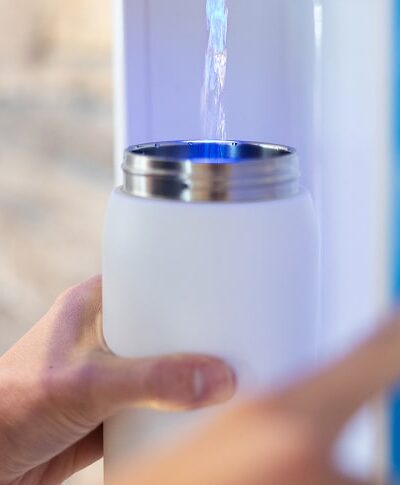Updated July 7, 2024
It’s normal for a city’s water filtration system to use chlorine to disinfect drinking water and kill germs. During the chlorination process, hypochlorite solution, or solid calcium hypochlorite, is mixed in the water. It is, then, dispersed at low levels to eliminate germs but keep the water safe to drink. However, depending on the amount of chlorine used or your sensitivity to the chemical, it can become a contaminant during the chlorination and cause health risks .
A chlorine water filter specializes in chlorine removal from your tap water to result in safer, cleaner drinking water. Although what’s currently in your tap water has been deemed at levels low enough to consume safely, it still may not smell or taste pleasant, which prohibits you from drinking the daily recommended amount of water to maintain good health.
Avoid consuming chlorine and its by-products by using a chlorine filter that also removes other pollutants that make your tap water less than desirable to drink. FloWater’s advanced purification system includes an activated carbon filter, which eliminates unwanted odors and tastes, as well as chlorine, radon, hydrogen sulfide, and other impurities and contaminants that affect the water quality.
It’s good to know the possible side effects of chlorine in drinking water, why it’s added to your tap, and the alternative options available to ensure you’re drinking the freshest water possible.
Is Chlorine in Drinking Water Harmful?
The Centers for Disease Control and Prevention (CDC) considers chlorine levels of up to four milligrams per liter safe in drinking water. The majority of community water systems switch between the use of chlorine disinfection and chloramine during their water treatment processes.
The purpose of the switch is because chlorine results in disinfection by-products, which can cause illness after a prolonged period of drinking the water. These by-products form in the pipes when the source water has high levels of dirt or germs that react with chlorine. Its alternative, chloramine, lasts longer in water pipes and develops fewer by-products while still removing the scum buildup that accumulates in water system pipes.
In addition to the water treatment guidelines established by the Environmental Protection Agency (EPA), individual municipalities may have their own guidelines, which means some systems may have less chlorine than others or use only chloramine as part of its disinfectant protocols. Each year, around July, your water utility should send a Consumer Confidence Report that shares details about the water quality of what comes out of your tap, including how much chlorine and/or chloramine is used.
Why Chlorine Is Added to Drinking Water
Chlorine is added to public water systems throughout the country to kill a variety of microbial waterborne pathogens. This treatment has been in place since the early 1900s to eliminate bacteria that caused typhoid fever. It’s also a helpful barrier against bacteria that leads to dysentery and Legionnaires’ disease. When small amounts are added to the water, the body is typically able to neutralize the chlorine. At high concentrations, however, is when chlorine can damage cells.
For chlorine to take effect against microorganisms, there must be a sufficient amount and sufficient time for it to react. This is usually 30 minutes to ensure a certain amount of chlorine stays in the water after treatment. Any residual chlorine is what you may smell in your tap water. Those with sensitivities may want to invest in a chlorine water filter to remove any presence of the chemical at all.
Amendments to the Safe Drinking Water Act regulates the by-products of chlorine added to drinking water can cause. To uphold these regulations, water treatment plants reduce the amount of chlorine they use, change the timing for when chlorine is added in the disinfection process, change the type of chlorine used, and/or remove the organic material that reacts to produce these harmful by-products.
As a disinfectant, chlorine has proven effective in killing bacteria but doesn’t filter all contaminants, and in some cases, its harmful effects may outweigh the pros.
Side Effects of Chlorine in Drinking Water
According to the EPA, potential exposure above its established chlorine levels may result in eye/nose irritation, stomach discomfort, anemia, and effects on infants and young children’s nervous systems. Once mixed in with water, chlorine interacts with organic compounds to create trihalomethanes, encouraging free radical growth that can damage or destroy vital cells.
Research published in the World Journal of Gastrointestinal Oncology links chlorine in drinking water to higher incidences of colorectal cancer and bladder cancer. The World Health Organization also identifies exposure to chlorine in drinking water as an asthma trigger and may result in dermatitis.
Although chlorine-treated drinking water at regulated levels isn’t deemed harmful to humans, the by-products may cause adverse effects, especially among vulnerable people, such as children and pregnant women, who may be more susceptible. On a smaller scale, the water’s smell and taste may prevent people from getting the daily hydration necessary to promote good health.
Does Your Home Have a Chlorine Water Filter System?
The best way to eliminate bacteria and other contaminants and pollutants found in tap water is to install a chlorine water filter system. The CDC recognizes reverse osmosis, distillation, and ultraviolet treatment systems with pre-filtration as effective processes for removing bacteria and viruses.
Reverse osmosis filters water through a semipermeable membrane with a pore size of approximately 0.0001 microns. This effectively removes protozoa, bacteria, viruses, and main metals found in drinking water, such as copper, chromium, lead, and chloride. Distillation offers similar benefits by heating water to a boiling point and collecting the water vapor as it condenses.
Ultraviolet treatment systems are unique in that they use ultraviolet light to disinfect water or reduce the amount of bacteria in the water. However, it doesn’t work against removing chemicals and should be used with a pre-filtration process for effectiveness.
Additionally, choosing the water filtration method is based on the level of purification you want and the amount of water you are looking to filter at once. For example, filtration pitchers are convenient but don’t hold a large amount of water compared to a filter installed on your sink’s faucet. Also, consider how often you’ll need to change the filter and how much space it’ll take up when choosing what is best for your lifestyle.
The FloWater Faucet Filter transforms your tap water into purified, great-tasting water that removes 80+ known contaminants and reduces microplastics frequently found in tap water with a five-stage micro carbon block filter process. It’s easy to install and provides twice the flow rate of the typical faucet filter. Also, it is a chlorine water filter that removes other solid and dissolved particles and pollutants commonly found in tap water.
Choosing Advanced Filtration for Cleaner Water
Public water systems must meet the safe drinking water standards set forth by the EPA, and many systems also have extensive protocols in place for higher water quality levels. However, there are still pollutants left behind that make their way to your tap water.
A healthier drinking option is FloWater, which removes up to 99 percent of all contaminants. The filtration process uses your water supply, or tap water source, and purifies it into crisp, clean water. There are three stages of filtration: purify, improve, and finish.
Purify
In the purification stage, tap water is passed through three separate filters. The first is the sediment filter that captures dirt, rust, and other solid impurities in your pipes or tap water. The second activated carbon filter removes the smaller particles, such as chlorine, hydrogen sulfide, and heavy metals, along with the unpleasant odors and tastes that accompany these materials. Third, the advanced osmosis system relies on a semipermeable membrane to filter out any remaining pollutants including bacteria, viruses, lead, and pesticides.
Improve
Once the water is thoroughly purified, it enters the improvement stage to add back valuable minerals that have been stripped out in the previous stages. The fourth step of the filtration process uses activated oxygen to sanitize the tanks and internal system naturally. It, also, increases the level of oxygen available for your blood and muscles and improves the taste of your filtered and purified water for your home.
The fifth stage is an alkaline enhancement that adds ten trace minerals that neutralize your body’s acidity and alleviate stress on your organs that work hard to rid your body of acid from stress, an unbalanced diet, and everyday environmental impurities. Following that is the electrolyte enhancement, which adds in calcium, sodium, magnesium, and potassium to the water. These electrolytes help keep you energized and hydrated throughout the day.
Finish
Finally, the carbon coconut filter adds the crisp, fresh taste by using real coconut husks to capture any lingering particles, odors, and tastes. The result is pure, clean water that tastes great and is free from contaminants found in tap water.
Drinking water is an essential part of maintaining good health. To get the hydration you need everyday sans the chemicals like chlorine, pollutants, and other contaminants, FloWater delivers a more satisfying, safer water experience.
Sources:
- https://www.cdc.gov/healthywater/drinking/public/chlorine-disinfection.html
- https://www.epa.gov/ground-water-and-drinking-water/national-primary-drinking-water-regulations
- https://www.ncbi.nlm.nih.gov/pmc/articles/PMC4824718/
- https://www.who.int/water_sanitation_health/dwq/chlorine.pdf
- https://www.scientificamerican.com/article/how-does-chlorine-added-t/
- https://www.cdc.gov/healthywater/drinking/home-water-treatment/household_water_treatment.html





